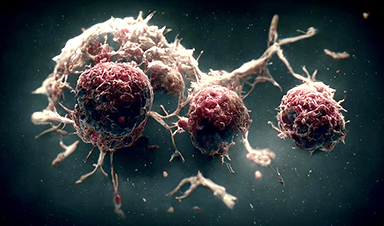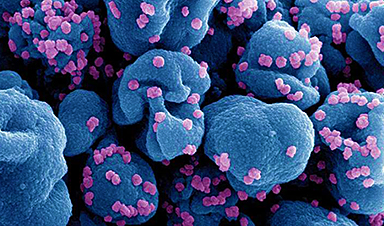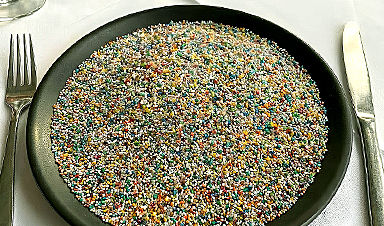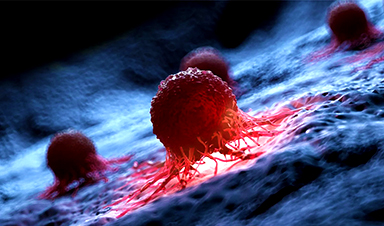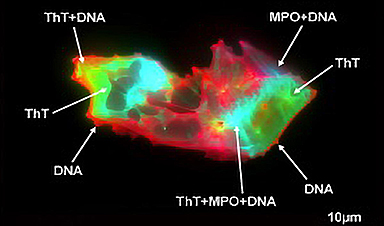Researchers at Cold Spring Harbor Laboratory have found that blocking the FGFR2 and EGFR genes can stop early-stage pancreatic cancer from progressing, offering a promising path toward prevention.
Pancreatic cancer is expected to become the second-leading cause of cancer-related deaths by 2030. One of the main challenges is that it’s often diagnosed at an advanced stage, making effective treatment difficult. As a result, combating pancreatic cancer, whether at the individual or population level, can feel like a race against time. Cold Spring Harbor Laboratory (CSHL) Professor and Cancer Center Director David Tuveson captures this urgency with a powerful analogy:
“We all have moles on our skin. Most of your moles are fine. But some of your moles you have a dermatologist looking at to make sure it’s always fine. They may take it out and send it to the pathologist to ask, ‘Is this an early melanoma, a melanoma in situ?’ Now, that’s just what you can see. Imagine that in your pancreas—because that’s the reality. We all have early versions of cancer in many tissues at all times.”
Now imagine treating those “early versions” in the pancreas—before they become cancerous. A new discovery at the CSHL Cancer Center could help make this possible. Tuveson and Research Investigator Claudia Tonelli have found a way to effectively “intercept” pancreatic cancer. To understand how it works, we need to first understand a little bit about pancreatic cancer genetics.
The Role of KRAS and FGFR2
“Over 95% of pancreatic cancer patients have mutations in KRAS,” Tonelli explains. “It’s the driving oncogene in this disease. We discovered that another gene, FGFR2, plays a role in enhancing mutant KRAS signaling in pancreatic cancer. When that happens, those ‘early versions’ of pancreatic cancer become much more aggressive.”

Tonelli and Tuveson observed this outcome in mice and organoids—lab-grown versions of human pancreatic tissue. Of course, the researchers weren’t just having a look. Their goal was to stop the pancreatic tissue from becoming cancerous. Because FGFR2 is a known oncogene in other cancers, several inhibitors are already used in the clinic today.
When Tonelli and her colleagues inhibited FGFR2 at precisely the right moment, they got the results they wanted. Tumor formation slowed significantly. When they targeted FGFR2 along with EGFR—a protein known to be overactive in pancreatic cancer—they saw even better results. Fewer “early versions of cancer” formed in the first place.
“With an increasing number of FGFR2 inhibitors entering the clinic, our study lays the foundation to explore their use in combination with EGFR inhibitors for pancreatic cancer interception,” Tonelli says. Patients with a family history of pancreatic cancer would likely be among the first candidates to receive such treatments.
For now, fighting pancreatic cancer remains a race against time. But with this discovery, the day may soon come when time is on our side.
Reference: “FGFR2 Abrogation Intercepts Pancreatic Ductal Adenocarcinoma Development” by Claudia Tonelli, Astrid Deschênes, Victoria A. Gaeth, Amanda Jensen, Nandan Vithlani, Melissa A. Yao, Zhen Zhao, Youngkyu Park and David A. Tuveson, 2 April 2025, Cancer Research.
DOI: 10.1158/0008-5472.CAN-24-4576
News
Fever-Proof Bird Flu Variant Could Fuel the Next Pandemic
Bird flu viruses present a significant risk to humans because they can continue replicating at temperatures higher than a typical fever. Fever is one of the body’s main tools for slowing or stopping viral [...]
What could the future of nanoscience look like?
Society has a lot to thank for nanoscience. From improved health monitoring to reducing the size of electronics, scientists’ ability to delve deeper and better understand chemistry at the nanoscale has opened up numerous [...]
Scientists Melt Cancer’s Hidden “Power Hubs” and Stop Tumor Growth
Researchers discovered that in a rare kidney cancer, RNA builds droplet-like hubs that act as growth control centers inside tumor cells. By engineering a molecular switch to dissolve these hubs, they were able to halt cancer [...]
Platelet-inspired nanoparticles could improve treatment of inflammatory diseases
Scientists have developed platelet-inspired nanoparticles that deliver anti-inflammatory drugs directly to brain-computer interface implants, doubling their effectiveness. Scientists have found a way to improve the performance of brain-computer interface (BCI) electrodes by delivering anti-inflammatory drugs directly [...]
After 150 years, a new chapter in cancer therapy is finally beginning
For decades, researchers have been looking for ways to destroy cancer cells in a targeted manner without further weakening the body. But for many patients whose immune system is severely impaired by chemotherapy or radiation, [...]
Older chemical libraries show promise for fighting resistant strains of COVID-19 virus
SARS‑CoV‑2, the virus that causes COVID-19, continues to mutate, with some newer strains becoming less responsive to current antiviral treatments like Paxlovid. Now, University of California San Diego scientists and an international team of [...]
Lower doses of immunotherapy for skin cancer give better results, study suggests
According to a new study, lower doses of approved immunotherapy for malignant melanoma can give better results against tumors, while reducing side effects. This is reported by researchers at Karolinska Institutet in the Journal of the National [...]
Researchers highlight five pathways through which microplastics can harm the brain
Microplastics could be fueling neurodegenerative diseases like Alzheimer's and Parkinson's, with a new study highlighting five ways microplastics can trigger inflammation and damage in the brain. More than 57 million people live with dementia, [...]
Tiny Metal Nanodots Obliterate Cancer Cells While Largely Sparing Healthy Tissue
Scientists have developed tiny metal-oxide particles that push cancer cells past their stress limits while sparing healthy tissue. An international team led by RMIT University has developed tiny particles called nanodots, crafted from a metallic compound, [...]
Gold Nanoclusters Could Supercharge Quantum Computers
Researchers found that gold “super atoms” can behave like the atoms in top-tier quantum systems—only far easier to scale. These tiny clusters can be customized at the molecular level, offering a powerful, tunable foundation [...]
A single shot of HPV vaccine may be enough to fight cervical cancer, study finds
WASHINGTON -- A single HPV vaccination appears just as effective as two doses at preventing the viral infection that causes cervical cancer, researchers reported Wednesday. HPV, or human papillomavirus, is very common and spread [...]
New technique overcomes technological barrier in 3D brain imaging
Scientists at the Swiss Light Source SLS have succeeded in mapping a piece of brain tissue in 3D at unprecedented resolution using X-rays, non-destructively. The breakthrough overcomes a long-standing technological barrier that had limited [...]
Scientists Uncover Hidden Blood Pattern in Long COVID
Researchers found persistent microclot and NET structures in Long COVID blood that may explain long-lasting symptoms. Researchers examining Long COVID have identified a structural connection between circulating microclots and neutrophil extracellular traps (NETs). The [...]
This Cellular Trick Helps Cancer Spread, but Could Also Stop It
Groups of normal cbiells can sense far into their surroundings, helping explain cancer cell migration. Understanding this ability could lead to new ways to limit tumor spread. The tale of the princess and the [...]
New mRNA therapy targets drug-resistant pneumonia
Bacteria that multiply on surfaces are a major headache in health care when they gain a foothold on, for example, implants or in catheters. Researchers at Chalmers University of Technology in Sweden have found [...]
Current Heart Health Guidelines Are Failing To Catch a Deadly Genetic Killer
New research reveals that standard screening misses most people with a common inherited cholesterol disorder. A Mayo Clinic study reports that current genetic screening guidelines overlook most people who have familial hypercholesterolemia, an inherited disorder that [...]



